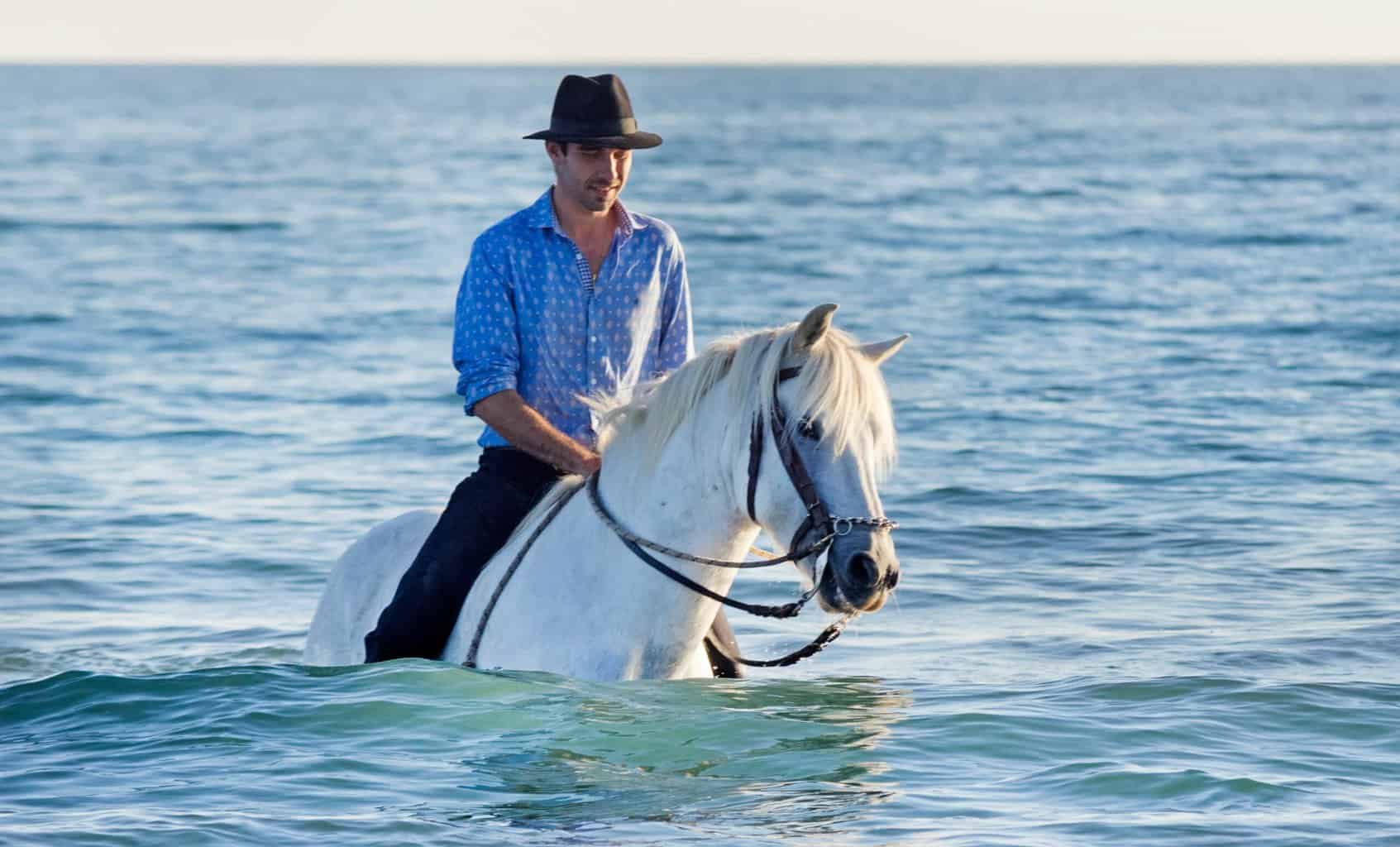- Can Horses Eat Watermelons - September 23, 2023
- How to Get a Horse to Trust You - September 21, 2023
- Best Horse Wormers for Spring Guide - August 10, 2023
Not only can horses swim, but they are strong, competent swimmers. Horses have a natural affinity with the water – and despite their size, most of them can swim effortlessly. That said, some horses are more willing to swim than others.
If galloping along the beach and bathing with your equine friend is on your bucket list, below, I’ll unravel the answer to the question, can horses swim?
Can Horses Swim?
Swimming is a crucial part of a horse’s survival instinct. In the wild, they often cross the water to access new pastures or escape from predators. Domesticated equines, however, may be wary of the water because they’re not used to it.
Most horses enjoy swimming and they move through the water using their legs as paddles – in a motion similar to trotting. They use their head and neck for balance, the tail acts like a rudder, and their huge inflated lungs help keep them afloat.
Unlike on land, where horses can reach speeds up to 54 mph (88 kph), they are incredibly slow in the water and swim no faster than 2.5 mph (4 kph).
Horses can’t hold their breath like humans, so their mouths and nose must always be out of the water. There is a serious drowning risk if they go below the surface.
Horses and Swimming – The Benefits
Horses enjoy the same health benefits as humans do when they go for a swim, including:
- Exercise and Fitness – Swimming is a fantastic low-impact exercise which builds muscle mass, lung capacity and stamina. It works all the muscle groups and is an outstanding way to build fitness.
- Fun and Relaxing – If horses like swimming, they will find it fun and relaxing. I like to take horses swimming for a change of scenery and to cool them down in the summer.
- Rehabilitation – Hydrotherapy is the perfect way to help horses recover from leg injuries. Hydrotherapy must be approved by a veterinarian and performed by trained professionals in an equine hydrotherapy center.
Can I Swim With a Horse?
Not all horses like to swim, but if your horse enjoys being in the water, then you can safely swim together. I find that horses who don’t like water, i.e. they avoid stepping in puddles, may be reluctant to swim. A horse may also fear the water if they’ve had a bad experience.
If a horse is scared of the water, I build their confidence slowly and gently coax them – I never force them to go in. Horses also feel safer in a herd – and a water-shy horse may follow a confident one into the water.
Swimming in Salt Water vs Fresh Water
I live on a small island and can access the sea easily, but if you don’t live near the coast, you can swim in creeks, rivers or lakes. However, there are differences between swimming in salt water and swimming in freshwater, which we’ll look at below.
Swimming in Salt Water
Swimming in salt water, such as the sea, is less strenuous for horses because the water is more buoyant. I love riding along the beach, and it’s easy to access the water from the gentle, sloping sand, which is firm underfoot.
The downside to swimming in the sea is that soft sand can cause stress on the leg tendons. The sea is also more unpredictable, and conditions can change quickly. You must also be vigilant of boat traffic or sudden drop-offs in the sea bed.
Swimming in Freshwater
Swimming with horses in freshwater, such as a creek, is perfect if you don’t live near the coast. Freshwater conditions are usually calmer and more consistent than the sea.
The problem with swimming in rivers and creeks is that they can be hard to get in and out of because of the soft footing. It’s also common for horse and rider to pick up leeches in freshwater – so always check for them after swimming.
How to Swim with a Horse
I always remove my saddle before swimming because it improves my contact and allows the horse to move freely, not to mention that I don’t want to destroy it. Some of my riding buddies like to use bareback pads for swimming.
As for headgear, you must be able to control a horse in the water, and I use a nylon bitless bridle or halter with reins attached. I like to leave my horse’s mouth empty, but some riders use a bit.
I never use martingales or straps which restrict a horse’s neck movement. It’s severely dangerous and could result in drowning. Horses need free use of their neck to swim. I also try to keep their ears dry because horses feel uncomfortable with water in their ears, and it could lead to an infection.
While swimming, I constantly monitor my horse’s body language. If a horse shows signs of fatigue, I leave the water immediately.
For your safety, never enter the water with a horse if you can’t swim or if the horse has any back or lung issues. Never go swimming alone – and always use the correct safety gear such as a wetsuit, life jacket, and riding helmet.
Can Horses Swim – Safety Tips
Swimming with horses is tremendous fun, but it can be dangerous, and there is a real risk of drowning or injury in the water. To get the best from the experience, I always stick to the following safety tips:
- Check the conditions – Never swim in strong currents.
- Get permission – Some rivers are reserved for fishing, and where I live, horses aren’t allowed on the beach during the summer. Always get permission from the landowner or local authority before you go swimming.
- Do a safety check – Ensure you can enter and exit the water safely, and be aware of hazards, such as rocks or dangerous aquatic creatures.
- Never go alone – Swimming alone with your horse is dangerous – always go with a group or partner.
- Introduce horses slowly – Be patient and let horses get into the water at their own pace – never force them.
- Stay calm – If your horse panics, the best thing you can do is stay calm.
- Monitor for fatigue – Leave the water immediately when the horse is tired.
- Watch out for rolling – Most horses roll after being in the water, so get ready to dismount if they do.
FAQs
Answer: How far a horse can swim depends on its fitness level and the water conditions. Horses use more energy swimming against the current and in cold or wavy water. If I take a horse swimming for the first time, I swim for 5 – 10 minutes, around ¼ of a mile, and build up the distance gradually over many sessions. The maximum I swim with a horse is half a mile.
Answer: Some horses love the water, and you can’t keep them out, while others hate water, and there’s nothing you can do to get them in. I find most horses like being in the water, especially on a hot day, to cool down.
Answer: Horses can’t hold their breath like humans and must have their mouths and nostrils above the surface. If a horse’s head goes underwater, it can drown. If I notice a horse is sinking, I push them on because forward movement helps keep them afloat.
Can Horses Swim – Summary
Horses are confident swimmers, and most enjoy a dip in the sea or a lake. But, if a horse doesn’t like swimming, I never force them into the water.
I love swimming with horses, but it can be dangerous, and to reduce the risks, I always go in a group and wear appropriate safety gear. You should never swim with a horse if you can’t swim, or if the horse has back or lung issues.
Resources
- Henry, M. (2023, April 26). Can horses swim? Discovering equine swimming secrets. horseracingsense.com. https://horseracingsense.com/can-horses-swim-float-or-sink/
- Jurga, F. (2019). 10 questions to answer before you swim with your horse. Equus Magazine. https://equusmagazine.com/blog-equus/summer-fun-swim-horse-questions-29559/
- Liv. (2021). Go swimming with your horse. Pro Equine Grooms. https://proequinegrooms.com/tips/grooming/go-swimming-with-your-horse/
- Redrup, G., & Redrup, G. (2021). Can horses swim? What you need to know before you start. Horse & Hound. https://www.horseandhound.co.uk/features/can-horses-swim-750010




